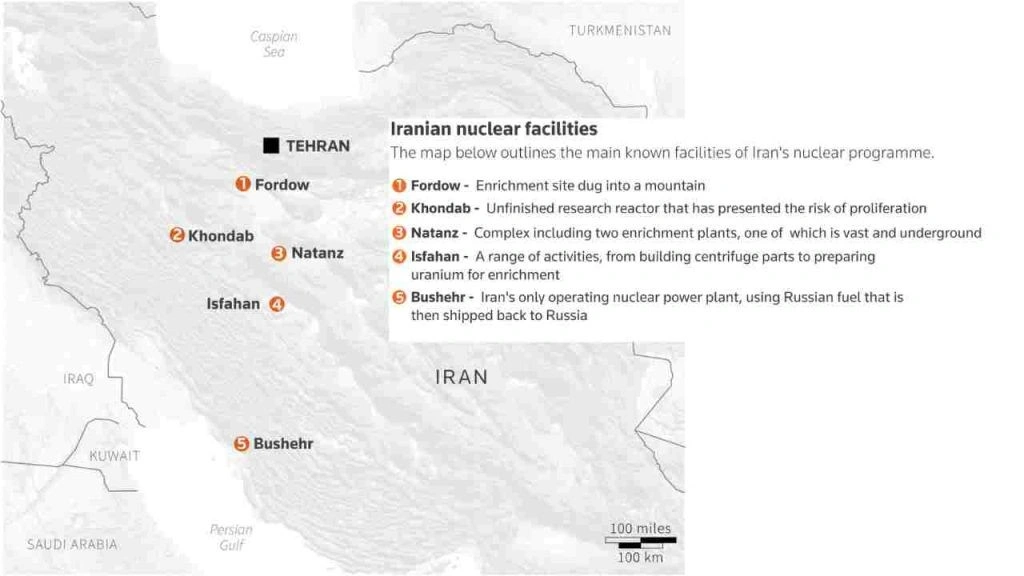Paper: GS – II, Subject: International Relations, Topic: Global issues, Issue: Recent strikes on Iran and implications for Iran’s Nuclear Programme.
Context:
Military strikes targeting Iranian nuclear facilities and scientists raise the question: Can Iran’s Nuclear Programme be dismantled through military means?
Key Highlights:
Inside Iran’s Nuclear Programme:
- Strategic Design: Iran has created a militarily resilient nuclear infrastructure.
- Key Sites:
- Fordow and Natanz – deeply buried under reinforced concrete and rock.
- Located inside mountains, e.g., Fordow is 80–100 meters underground.
- Protection Features: The sites are air-defended with layered systems. Further the use of bunkers makes aerial attacks largely ineffective.

Limitations of Military Options Iran’s nuclear sites:
- Challenges for Conventional Weapons: Even precision-guided munitions like the U.S. GBU-57 MOP (Massive Ordnance Penetrator) may not guarantee complete destruction. MOPs require optimal conditions (e.g., hardened targets at shallow depth).
- Reconstruction Capability: Iran has demonstrated an ability to quickly rebuild damaged infrastructure (e.g., post-2010 Stuxnet attack).
- Historical Precedents vs. Iran Case: Though Israel destroyed Iraq’s Osirak reactor (1981) and Syria’s al-Kibar (2007) nuclear sites. Iran’s nuclear infrastructure is spread out, deeply buried, and technologically matured.
- Integrated facilities: Iran’s nuclear infrastructure is integrated with military-industrial complex and scientific institutions Unlike Syria/Iraq where no visible or centralized “bomb factory” exists.
- Iranian Deterrence: Iran has warned that military action would provoke a “crushing” retaliation and demonstrated capabilities through regional allies and missile/drone strikes.
- Cycle of Escalation: Bombing Iran could escalate into a “forever war” cycle of tit-for-tat.
A Better Alternative:
- Reviving JCPOA: 2015 Joint Comprehensive Plan of Action curbed Iran’s uranium enrichment. U.S. exit under Trump weakened the deal though recent talks have aimed to restore terms.
- IAEA Monitoring: Iran continues to allow inspections under IAEA. Current enrichment levels (up to 60%) are still below weapons-grade (90%).
- Pragmatic approach: Diplomacy, verification, economic sanctions, and regional cooperation offer a more sustainable approach.
Conclusion:
Iran’s nuclear programme is a hardened, dispersed, and resilient system. A surgical military strike is unlikely to fully dismantle it and could backfire strategically. For international peace and stability, reviving diplomacy and multilateral agreements like the JCPOA is crucial.
La Excellence IAS Academy, the best IAS coaching in Hyderabad, known for delivering quality content and conceptual clarity for UPSC 2025 preparation.
FOLLOW US ON:
◉ YouTube : https://www.youtube.com/@CivilsPrepTeam
◉ Facebook: https://www.facebook.com/LaExcellenceIAS
◉ Instagram: https://www.instagram.com/laexcellenceiasacademy/
GET IN TOUCH:
Contact us at info@laex.in, https://laex.in/contact-us/
or Call us @ +91 9052 29 2929, +91 9052 99 2929, +91 9154 24 2140
OUR BRANCHES:
Head Office: H No: 1-10-225A, Beside AEVA Fertility Center, Ashok Nagar Extension, VV Giri Nagar, Ashok Nagar, Hyderabad, 500020
Madhapur: Flat no: 301, survey no 58-60, Guttala begumpet Madhapur metro pillar: 1524, Rangareddy Hyderabad, Telangana 500081
Bangalore: Plot No: 99, 2nd floor, 80 Feet Road, Beside Poorvika Mobiles, Chandra Layout, Attiguppe, Near Vijaya Nagara, Bengaluru, 560040
